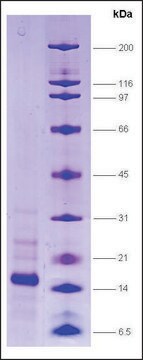SRP2120
RNA Polymerase II Peptide
≥70% (SDS-PAGE), human recombinant, expressed in E. coli, GST tagged
Synonim(y):
POLRA, RPB1, RPO2, RPOL2, hRPB220
About This Item
Polecane produkty
product name
RNA Polymerase II, C-terminal domain, GST tagged human, recombinant, expressed in E. coli, ≥70% (SDS-PAGE)
pochodzenie biologiczne
human
rekombinowane
expressed in E. coli
Próba
≥70% (SDS-PAGE)
Postać
frozen liquid
masa cząsteczkowa
~68.1 kDa
opakowanie
pkg of 10 μg
warunki przechowywania
avoid repeated freeze/thaw cycles
kolor
clear colorless
numer dostępu NCBI
numer dostępu UniProt
Warunki transportu
dry ice
temp. przechowywania
−70°C
informacje o genach
human ... POLR2A(5430)
Powiązane kategorie
Działania biochem./fizjol.
Postać fizyczna
Uwaga dotycząca przygotowania
Kod klasy składowania
10 - Combustible liquids
Klasa zagrożenia wodnego (WGK)
WGK 1
Temperatura zapłonu (°F)
Not applicable
Temperatura zapłonu (°C)
Not applicable
Certyfikaty analizy (CoA)
Poszukaj Certyfikaty analizy (CoA), wpisując numer partii/serii produktów. Numery serii i partii można znaleźć na etykiecie produktu po słowach „seria” lub „partia”.
Masz już ten produkt?
Dokumenty związane z niedawno zakupionymi produktami zostały zamieszczone w Bibliotece dokumentów.
Nasz zespół naukowców ma doświadczenie we wszystkich obszarach badań, w tym w naukach przyrodniczych, materiałoznawstwie, syntezie chemicznej, chromatografii, analityce i wielu innych dziedzinach.
Skontaktuj się z zespołem ds. pomocy technicznej








